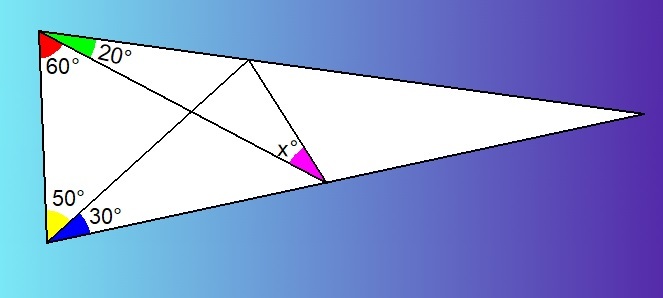This section requires Javascript.
You are seeing this because something didn't load right. We suggest you, (a) try
refreshing the page, (b) enabling javascript if it is disabled on your browser and,
finally, (c)
loading the
non-javascript version of this page
. We're sorry about the hassle.

Since the angles of a triangle are preserved under uniform scaling, we can assume that the base BC = 1 .
It is staright-forward to see that △ BCD is isosceles because ∠ CDB = 5 0 ∘ .
Therefore, BC = CD = 1 .
Next, consider △ BCE , applying the Law of Sines,
sin 8 0 ∘ CE = sin 4 0 ∘ 1
So, CE = sin 4 0 ∘ sin 8 0 ∘
Finally, consider △ CDE , and apply the Law of Sines again, (noting that ∠ CDE = 1 6 0 ∘ − x )
sin x CD = sin ( 1 6 0 ∘ − x ) CE
CE sin x = sin ( 1 6 0 ∘ − x ) = sin 1 6 0 ∘ cos x − cos 1 6 0 ∘ sin x
Divide by cos x , and re-arrange,
tan x ( CE + cos 1 6 0 ∘ ) = sin 1 6 0 ∘
From which, we get tan x = 0 . 5 7 7 3 6 . . . . = 3 1 ,
Hence, x = tan − 1 3 1 = 3 0 ∘